
Review Article
Austin Chem Eng. 2024; 11(1): 1110.
A Digitalized Simulation Approach to Assist Technology Students
Gouws S*
Department of Chemistry, Nelson Mandela University, Gqeberha-6031, South Africa
*Corresponding author: Shawn Gouws Department of Chemistry, Nelson Mandela University, Gqeberha-6031, South Africa. Email: shawn.gouws@mandela.ac.za
Received: June 25, 2024 Accepted: July 12, 2024 Published: July 19, 2024
Abstract
In recent years, a talent shortage has been one of the biggest threats facing chemical and petrochemical organizations. This, together with declining employment, looming retirements, and sizeable demographic age gaps in the workforce, has made us, together with industry, determined to tackle the problem and bridge the gap by developing a formal course between a low-skill operator level and the process engineer. The attributes students need for the chemical industry and how this can be achieved through various education styles, from a teacher-centered approach to a student-centered approach that incorporates participation through group discussions and class presentations. To encourage life-long learning and critical skills development.
This paper will discuss how these students benefit from process simulations and how What-If scenarios can be used to pinpoint potential problems. Once problems have been identified through simulation, the students will implement a corrective plan to mitigate the risk successfully.
The objective was to develop a platform for students to learn a hands-on approach to process control. To apply classroom process control education to real-world examples.
Feedback from students on the hands-on approach will be discussed.
Keywords: Technology; Chemical Processing; Education; Simulation; Process Control
Introduction
Shortcomings in technology education have been summarised in the last couple of decades [1] to strengthen the fundamental coverage of chemical engineering principles. This is achieved by teaching about "real-world" engineering design and operations, which includes quality management systems, covering more materials in frontier areas of chemical processing, offering better instructions as standard operating procedures both verbally and textualized communication and teamwork skills; providing training in academic and professional skills that elaborate on problem- solving skills, troubleshooting skills, and critical thinking [2]. Figure 1 illustrates the complexity of a process operator job in the 21st century [3].
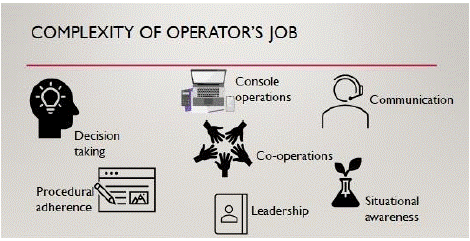
Figure 1: Complexity of process operators’ job.
Curriculum Development
A chemical engineering course needs to be curricula to produce all-around graduates. That can be knowledgeable with the chemical process technology principles needed in a chemical industry environment. The average student can complete this study in the three years specified to graduate.
To accomplish this curriculum as single subjects (e.g., chemical processing, heat transfer, thermodynamics, process technology, technical writing, etc.) would take several years for the student to complete with the desired proficiency in the fundamentals and be familiar with procedures of modern chemical operator practices, culturally literate, skilled in communication and computer literacy.
More effective ways need to be covered in the curriculum to enable the students to tackle challenging multidisciplinary problems that call for cognitive thinking and creativity [4]. In the literature, several methodologies exist that deal with general education, technical education, and chemical engineering education and facilitate learning more effectively than the traditional single discipline lecturing approach [5]. A more hands-on instructional approach was developed that allows a student-centered approach to be followed. Instructional objectives are statements of what students should be able to do to demonstrate their abilities to master a specific skill or discipline.
From an educational perspective, the material course comprises books, internet sources, facts, and knowledge from peers and students in cases where books are the primary medium of choice. The resource tends to be abstract and impersonal. The examples are often from another country or period, and the students cannot relate, especially in an African context. If facts are chosen, it merely seeks and focuses on information about a topic. Therefore, combining different resources could shape the teaching material to provide a more comprehensive learning experience for the student.
African students are presented with textbooks from Europe or the USA that discuss illustrations not applicable in Africa. Therefore, examples need to be found in the African context to illustrate the meaning of the text. As continent rich in resources, plenty of examples can be used to drive the students' point.
This program will fill a real gap in the current South Africa Higher Education offering in support of local industry, which still needs to be met by current related programs. The industry has attempted to meet its needs through internal training programs. Still, increasing technical sophistication, environmental and health compliance requirements, and economic pressures to optimize processes require graduates to have a sound and multi-disciplinary education and training to maintain, operate, and optimize chemical process plants. The graduate will be able to find quality employment in various industries as this educational foundation is designed with industry participation to meet the needs of chemical and chemical-related industrial activities, e.g., bulk products storage, transport, and handling facilities. Figure 2 shows some essential attributes in cementing technology with the students in this program.
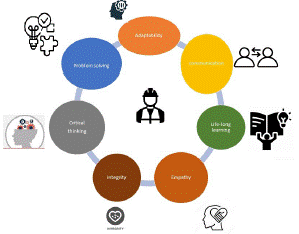
Figure 2: Teaching and learning attributes.

Figure 3: Progression in education [8].
Attributes
Student attributes are vital to developing an all-around graduate who can adapt to a working environment and has effective communication skills. To operate and function correctly in a chemical plant. To enable graduates to communicate with their peers and with stakeholders or clients. Instilling lifelong learning always improves one's thinking and performance. They are caring for one another and have empathy in their community. They must have integrity, punctuality, and honesty in their working and personal environments. Graduates and skilled employees need to be critical thinkers and solve problems as they arise with good educational and technical abilities.
Education Style Approaches
Over the last few years, my approach has incorporated most teaching philosophies in our Chemical Process Technology course. For example, in the 1st year, the modules offered will be on essentialism and perennialism philosophy [6] to bring the knowledge across to the students. Essential theories, fundamentals, and principles are taught in chemistry, mathematics, and physics to teach students the various physical science theories taught at the school level. We also must incorporate progressivism and pragmatism philosophies in more hands-on modules. Modules dealing with technology, in which the students are taught about chemical engineering principles and terminology, could better be explained through physical contact with the equipment.
The format of teaching was always a combination of theory and practice. To cover the introduction of the module, the principals involved with the various chemistries and basic chemical engineering concepts through cognitive, constructivism, and direct instruction.
The following segments of the chemical industry and academia are addressed:
• Groups that practice chemical science and chemical technologies should consider the implications of changes in chemistry education.
• Chemical educators involved in curriculum development for chemical technologies should consider relevant content of chemical education in chemical technology, specifically digitalization.
• Chemical technology researchers can formulate research questions to address the gaps in formal education.
• Creative, innovative entrepreneurs solve complex problems through troubleshooting and critical thinking abilities.
To develop life—and career-oriented skills such as social awareness and being a responsible citizen who can serve society. To be an environmental steward, we should look after our surroundings in flora and fauna to develop a sustainable future. To be ethical, we should treat everyone the same with integrity and respect and be accountable. We should also develop people skills that allow us to talk to Ubuntu with solid communication skills. To achieve these skills in our students, we as lecturers have equal responsibility in our attributes.
Traditional Education 1.0 (teaching) style is teacher-centered, where students must memorize fundamental concepts and terminology to progress to the next level. In Education 2.0 (research), the students interact with the Internet of Things (IoT), such as Google, YouTube, Open access AI, and Chat GPT, to search for more info and learn to complete assignments. In Education 3.0 (community service), this is a more progressive style of teaching and learning. In this knowledge-based education, the students interact in a classroom through role-play or group discussions. Education 4.0 is student-centered, where the students actively participate in classroom discussions and solve problems. Education 4.0 (innovation) is a learning experience that helps students build confidence. Most of the time in a classroom environment, the students, especially African students, shy away from engagement due to several factors out of respect for older adults but mainly due to language. It also depends on the student's schooling, whether they come from a rural area school or a previous model C -school where the language is English. This is also more project-based learning than the previous education styles, where a topic is given to the students to research and write a report on. This can also be presented in a classroom environment. Education 5.0 (industrialization) through critical thinking and lifelong learning [7].
Education 4.0 pushes the lecturer’s teaching strategies to provide knowledge that can be used for critical thinking development, life-long learning, and sustainability [9].
Education 5.0 (Figure 4) uses new technologies to provide more humanized teaching, focusing on students' social and emotional development and solutions that improve life in society. All social spheres – like work, industry, and health – have come to understand that technology can (and should) be favorable to life. Student-centered to respect and value people [10].
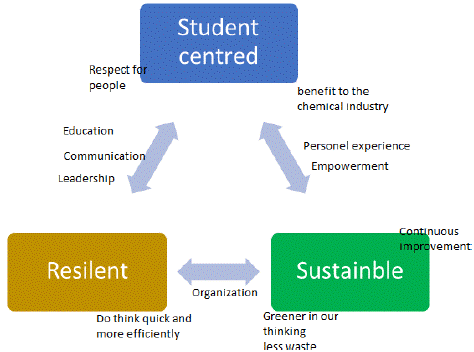
Figure 4: Education 5.0.
Three core elements of Industry 5.0:
1. Human-centric approach – putting human needs and interests at the heart of the production process by sub-ordering and adapting technology to humans, not vice versa.
2. Lifelong learning through self-motivation to pursue knowledge for personal or professional gain; this is important for social enhancement, competitiveness, and employability.
3. Resilience – developing more robustness in industrial production to become resilient towards self-awareness, mindfulness of others, self-care, positive relationships, and purpose.
Framework Strategy for Technology Language
A framework for developing strategies to incorporate indigenous languages into scholarship, teaching and learning pedagogies, and communication at South African public higher education institutes to enhance learning among our students is necessary to facilitate multilingual challenges that arise in a classroom environment.
Figure 5 shows the language distribution concerning the Diploma Chemical Process Technology program over the last three years. isiXhosa is the predominant language since the students are primarily from the Eastern Cape, with isiZulu in second place; the decline might be in these cohorts rather than in the overall geographics.
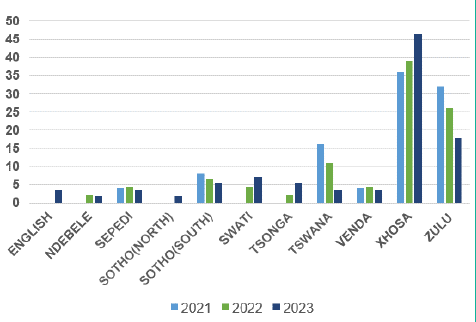
Figure 5: Home language distribution in the Diploma Chemical Process Technology course from 2021 to 2023.
Language training could help teachers communicate with their students through workshops and short training learning programs. Coordinating this could be very challenging, considering all the socio-economic problems and inequality when a student comes from a rural area.
To overcome these challenges of language barriers, several multilingual pedagogies can be implemented to assist students in the learning process. Multilingualism is using more than one language, either by the individual lecturer or in a group discussion. This can improve the cognitive skills of the individual when a particular idea or concept is explained in their home language. This also is cultural enrichment by knowing different languages. For example, the study material in English can be further described in an African language for better understanding. However, there are some challenges, such as language maintenance through proficiency, in the case of one language that is used more than others in a multi-language environment [11].
Chemical process learning relies on understanding the microscopic, mesoscopic, and macroscopic world and its connection to industrial processes. Thus, conceptual understanding requires skills related to the ability to represent and interpret chemical and industrial process problems using macroscopic, microscopic, and technological forms of representations [12]. For example, to understand how chemicals are broken and reformed by manipulating various factors on a tiny scale. Supplementary learning materials are available on digital media to assist textbook materials in providing more efficient learning to the students [13]. Video footage explains how technology can be used to separate hydrocarbons in a distillation process or how chemicals react with one another at the interface to produce new molecules. In this way, students can understand the relationship between chemistry and physics or chemistry and industrial processes. Learners can learn about chemistry, which has direct applications in everyday life. For example, ammonia can be produced from air separation and fossil fuels to create a cleaning agent. They are learning about organic chemicals that can save lives through the production of pharmaceuticals. Learners can learn and understand the chemistry that could solve social problems, such as the energy crisis from fossil fuels or green hydrogen from water splitting to reduce the carbon footprint. Learning about chemistry enables understanding the risks involved in various chemical processes, such as refineries and nuclear plants. They appreciate the chemistry in other disciplines, such as civil and polymerization processes, to make plastics and rubbers. They learn about the chemistry that could influence structures from the natural world, such as the corrosivity of salt water on iron objects or acid rain on construction sites.
What should this diploma chemical process technology curriculum teach to develop the next generation of graduates for digital technologies? For instance, digital models can be created to track the vital status of pumps, valves, and other rotational equipment to predict and measure variables such as critical quality attributes.
Textbooks have become digitalized in the last decade and are more frequently available as a study material source. Therefore, digital technologies are changing how books are published and accessed on various electronic platforms such as laptops, tablets, and smartphones.
Digital Simulation
Digital simulation for technicians refers to using computer-based simulations to replicate real-world scenarios, for example, how to drive a car, fly, or, through virtual reality, how to weld in a virtual environment. Virtual environments provide a safe environment for technicians to practice and enhance their skills without the risk of severe consequences in a real-world scenario. This allows operators to control and operate equipment, machinery, and systems to familiarize themselves with the controls, procedures, and troubleshooting [14].
Digital simulation for technicians is a valuable tool for training, testing, and optimizing various aspects of technical work across different industries. The technology continues to evolve, incorporating advancements such as artificial intelligence, machine learning, and more realistic modeling techniques to enhance its effectiveness [15].
Table 1 provides insight into how digitalization can be used to explain physical chemistry calculations. Numerous software packages assist in calculating thermodynamics, mass and energy balances, heat and mass transfer, separation process, process design, sustainability, process dynamics and control, and safety.
Subject
The digitalization of current practices
Thermodynamics
Visualization of temperature composition diagrams can enable improved insights.
Mass and energy balances
Carry out the elemental mass and energy balance of a unit operation using digital tools and visual aids to convey the basic concepts of mass and energy balances.
Heat and mass transfer
Analyze (and visualize) changes to heat and mass transfer as both the driving force and other parameters change.
Separation processes
Numerically model separation processes and scenario analysis.
Process design
Scenario analysis recycles and complex flowsheets. As pointed out by a respondent
Sustainability
Calculate the impacts of carbon footprint.
Process Dynamics and Control
Visualizations and implementation.
Safety
Visualization and scenario analysis
Table 1: The digitalization of current practices [17].
Simulation as an Educational Tool
Simulation is an educational learning tool that allows students to apply their theoretical knowledge and practical skills learned in a classroom environment by placing them in scenarios where they can actively solve problems [16]. Simulation learning encourages students to think critically. Simulation can be used to optimize a process, find faults in a system, improve safety, and test theories. Although instructional simulations can be very effective in encouraging students, pre-lessons are essential in providing a learning platform for students to learn from.
In a classroom, a student learns about process description (what a process is – raw materials and energy go into a reactor to bring about the breaking of bonds to produce new molecules), control philosophies (how different variables interact with one another to bring about a reaction, such as a temperature, pressure, flow rate, and level), mass and energy balance (the mass balance to reconcile amounts what enters into the reactor and what comes out of the reactor. In terms of conversions and yields), pipe and identification drawings (P&ID) Figure 6 (to be able to read and understand P&IDs to have a better understanding of the process).

Figure 6: Process levels from micro to meso to macro level.
Figure 6 illustrates the different levels associated with a process. At the micro level, the interaction between the reactant and the catalysts breaks bonds and reform bonds, as well as the kinetic rates and thermodynamics that take place to produce a new molecule through collisions and the parting of kinetic energy. On the meso-level, the process controls needed to bring about the reaction through the reactants' temperature, pressures, and flow rates—the layer of protection to ensure safe operations. Macro-level on plant level upstream and downstream chemical process to produce a final chemical or commodity product.
Real-World Scenarios
How does classroom teaching relate to real-world scenarios? As the picture illustrates below, it is safe in a classroom experience, but what happens if you take your vehicle on a wet, rainy road? Process control taught in a classroom with safe conditions differs from being experienced in a real-world scenario. Figure 7 compares a classroom experience and a real-world experience.
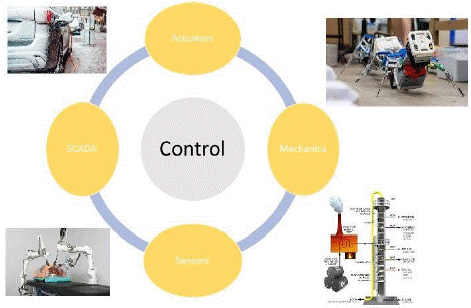
Figure 7: Comparison between classroom and real-world experiences.
The operator must rely on their training to avoid serious consequences, such as the toxic release of hazardous materials, flooding in a distillation tower, vehicle slipping in wet conditions, etc. Therefore, simulation programs are used with the course notes to advance training and cognitive thinking. Various practical objectives were developed and implemented to bridge the gap between theory and practice. This course focused on three process equipment modules as process simulation tools, such as heat exchangers, fluid flow, and centrifugal pumps; these are found in most chemical industries. The simulation software allows the students to interact by opening and closing valves, switching on pumps, and so on.
This occurs in a control room or from an outside/field operator’s perspective. The student then needs to discuss, as part of the objective, the operation mode involved in the process control. The simulation approach benefits students by enhancing their pedagogy and helping them become more competent and self-assured in the chemical plant environment. For this study, the acronym INSTO is introduced.
INSTO exercises train the student on critical points: 1) I or identification; it is essential to know the plant layout and why specific equipment is placed before another process begins. To see where the various equipment and instrumentations are in the plant and on the pipe and identification drawings (P&ID). In most industries, the control area is far removed from the plant; therefore, communication is vital to understand the process and the location of these rotational or stationary equipment to execute the task correctly and efficiently. To record these data of flow rates, level, pressure, and temperature precisely and to note non-process measurements such as speed, pump motor currents and potentials, and agitation speed, to name a few. 2) N or routine operations to identify how the equipment sounds, feels or smells is essential to understand the vitals of any operations. A “What-if” scenario can be discussed or created in the program. For example, EQUIPPED, e.q. – equipment, U – utilities, I – instrumentations, P – process, P – people, E – environment, and D – Downstream or upstream processes. All these or a combination can affect a process and lead to severe consequences. Equipment such as a pump or valve in an open or closed position can fail. Utilities can fail, such as through load shedding, so there is no power or water crisis if the municipal water pump pressure fluctuates. Processes can fail through blockages, or human shortcuts can lead to consequences. Procedures that might be unclear. People make human errors doing operations too quickly, taking shortcuts to avoid process steps. 3) S – standard operating procedures (SOP), starting up and shutting down a chemical plant is an essential operation that needs to be done to ensure the plant is commissioning correctly. In case there is an emergency, the process operator needs to know what action to take to mitigate any potential release of energy or hazardous materials into the atmosphere. 4) T – T-trending and troubleshooting: One of the major tasks or operations of a chemical technician is monitoring to ensure the process controls are working in good order. Trending is a tool operators can use to check process performance; for example, when a pump fails, it will show that the feed will stop on both the valve and effluent. Figure 8 shows a typical trend for a pump failure.
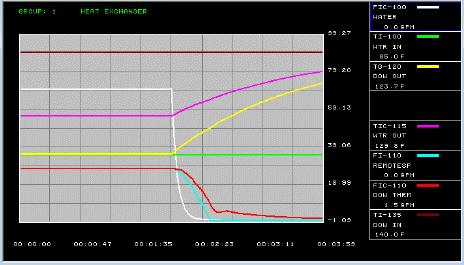
Figure 8: Pump failure [18].
These trending graphs assist in pinpointing the problem quickly and efficiently during a troubleshooting process. 5) O—Optimization of the effectiveness of the plant depends on optimization and how smoothly the plant will run. This can be done through continuous monitoring and calculations of the thermodynamics of heat transfer to establish if there is a decrease in plant or equipment performance.
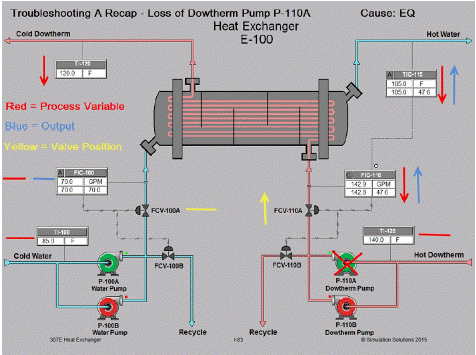
Figure 9: Control room view of a heat exchanger troubleshooting [18].
Figure 8 is an example of pump failure; the arrow on the diagram indicates what is happening at that point in the process. For example, when the pump fails, the operator needs to observe that the flow rate of the hot dowtherm oil starts to decrease. Therefore, the sensor T120 reduces since no hot oil is passing through. On the waterside, the water temperature to the customer will drop; therefore, the decrease arrow is in red. The blue arrows are valve outputs. This indicates that the valve is trying to force open by set point design to keep the process going. To mitigate the problem, the operator needs to assess how to tackle the problem through a few basic troubleshooting steps. There will be alarms going off in the control room. These need to be noticed to identify the problem and to start mitigating the problem. Trending graphs will also begin to show any deviations from the regular activity. Once the problem has been identified, suitable probable solutions must be formulated to ensure no severe consequences in the production plant. This could be from experience, hierarchy if the problem has previously occurred, or resources such as technical manuals that can be implemented. Figure 10 shows the steps for problem-solving.
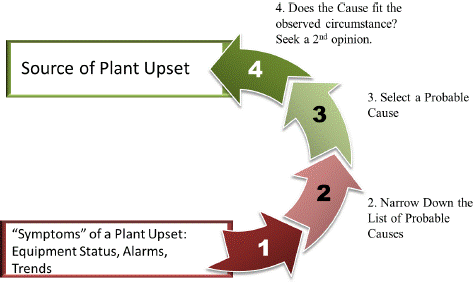
Figure 10: Problem-solving steps.
A questionnaire was completed to obtain student feedback. Overall, the students prefer this hands-on approach to a teaching-centered approach comprising standard lectures, assignments, and reports. The students can interact with the program by changing settings, opening and closing valves, and starting and shutting down pumps.
Conclusive Remarks
In teaching a technology course such as a Chemical Process Technology course, the students face several challenges that they need to overcome to become skilled as process operators. One of the significant challenges is sometimes a language barrier where English is not your first language, but all the course materials are in English. Several methodologies can be followed to overcome this challenge, such as translanguaging, where there is an understanding, but the parties can transverse in their language. Alternatively, through peer support, helping each other in a group discussion. A method I used was to draft and distribute a terminology glossary in the four main languages of this province to help students understand terminology concepts.
Educator researchers can explore innovative teaching methods, pedagogical approaches, and educational technologies to enhance the learning outcomes of chemical technology education. This could include simulations, virtual laboratories, flipped classrooms, or project-based learning experiences. Individuals from diverse backgrounds need to be more inclusive; therefore, the researcher needs to investigate curriculum design and promote diversity in STEM (science, technology, engineering, and mathematics). Research education needs to formulate research questions to develop students' critical thinking skills and ability to solve complex problems in chemical technology. Examples could be designing case studies, problem-based learning scenarios, or research projects encouraging students to apply their knowledge to real-world challenges, designing the curriculum, and collaborating with industry partners to understand their perspectives on the knowledge and skills needed by graduates of chemical technology programs. This can lead to internships and Work-Integrated Learning (WIL) opportunities that align with industry expectations. This can be done by formulating research questions that address these areas, and chemical technology researchers can contribute valuable insights to improve formal education programs and ensure that graduates are well-prepared to meet the demands of the chemical industry.
Author Statements
Acknowledgments
The author, SG, would like to thank the Nelson Mandela University and Teaching Development Initiative Fund for their support in learning and teaching at this university for Dr Melissa Gouws for proofreading the manuscript.
References
- Gouws S. Teaching for chemical process technicians, Education for chemical engineers. 2022; 39: 6-14.
- Thornhill-Miller B, Camarda A, Mercier M, Burkhardt JM, Morisseau T, Bourgeois-Bougrine S, et al. Creativity, Critical Thinking, Communication, and Collaboration: Assessment, Certification, and Promotion of 21st Century Skills for the Future of Work and Education. Journal of Intelligence. 2023; 11: 54.
- Henriksen D, Richardson C, Mehta R. Design thinking: A creative approach to educational practice problems. Thinking skills and Creativity. 2017; 1: 140-53.
- Jamaludin M Z, Yusof KM, Harun NF, Hassan SAHA. Crafting Engineering Problems for Problem-Based Learning Curriculum, Procedia - Social and Behavioral Sciences. 2012; 56: 377-387.
- Awang H, Ramly I. Creative thinking skill approach through problem-based learning: Pedagogy and practice in the engineering classroom. International Journal of Educational and Pedagogical Sciences. 2008; 2: 334-9.
- Felder RM. Engineering education: A tale of two paradigms. Shaking the foundations of Geo-Engineering education, 2012: 9-14.
- Broo DG, Kaynak O, Sait SM. I am rethinking engineering education at the age of Industry 5.0. Journal of Industrial Information Integration. 2022; 25: 100311.
- Ishteyaaq A, Sharma A, Singh R, Gehlot A, Priyadarshi N, Twala B. MOOC 5.0: A Roadmap to the Future of Learning. Sustainability. 2022; 14: 11199.
- Mladineo M, Cubic M, Gjeldum N, Crnjac ŽM. Human-centric approach of Lean management as an enabler of Industry 5.0 in SMEs. 2021; 111-117.
- Broo DG, Kaynak O, Sait SM. Rethinking engineering education at the age of Industry 5.0. Journal of Industrial Information Integration. 2022; 25: 100311.
- Dryers C, Anitia BE. Multilingual and multimodal mediation in one university module, the people, and processes involved, Southern African Linguistics and Applied Language Studies. 2019; 37: 1-15.
- Husband T. The Language of Chemistry, Education in Chemistry. RSC. 2016.
- Haleem A, Javaid M, Qadri MA, Suman R. Understanding the role of digital technologies in education: A review, Sustainable Operations and Computers. 2022; 3: 275-285.
- Gouws S. Digitalize Learning via Process Simulation to Understand Process Control. Austin Chem Eng. 2022; 9: 1092.
- Young BR, Mahoney DP, Svrcek WY. Real-time computer simulation workshops for the process control education of undergraduate chemical engineers. Comput Appl Eng Educ. 2001; 9: 57–62.
- Y Zhang, MT Munir, W Yu, BR Young. A real-time approach to process control education with an open-ended simulation tool. Educ Chem Eng. 2013; 8: e105-e112.
- Udugama IA, Atkins M, Bayer C, Carson J, Dikicioglu D, Gernaey KV, et al. Digital tools in chemical engineering education: The needs and the desires. Education for Chemical Engineers. 2023; 1: 63-70.
- Garvey M. PetroSkills – Simulation Solutions LTD. New Jersey. The USA. 2022.